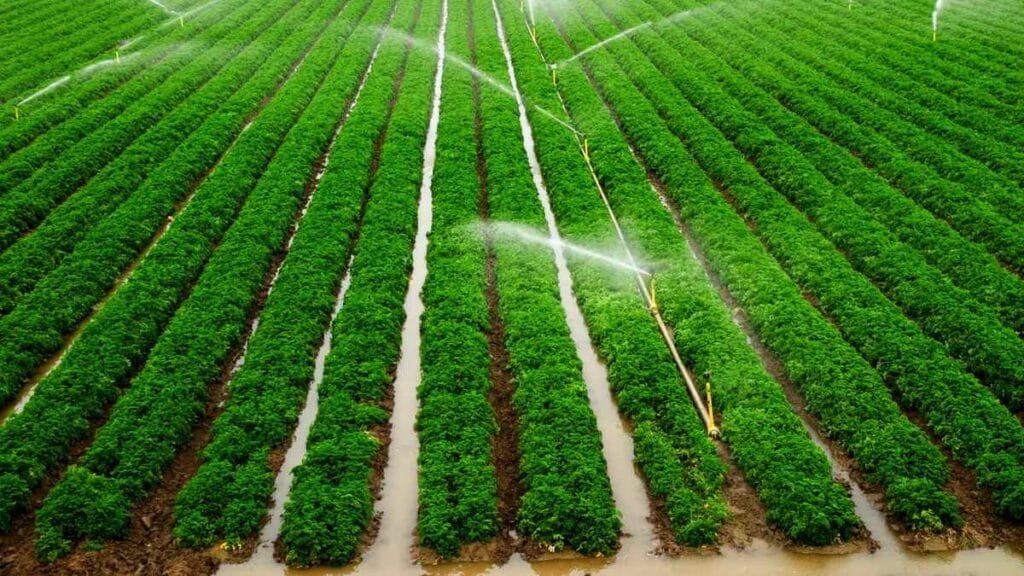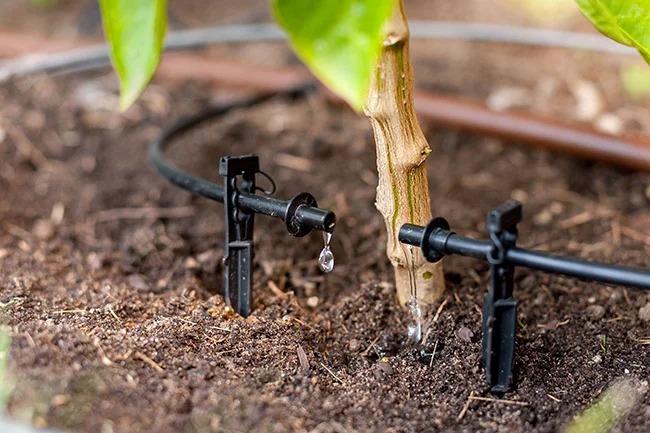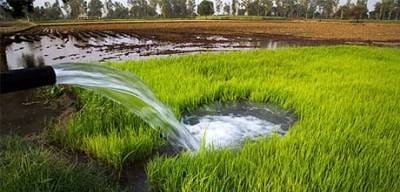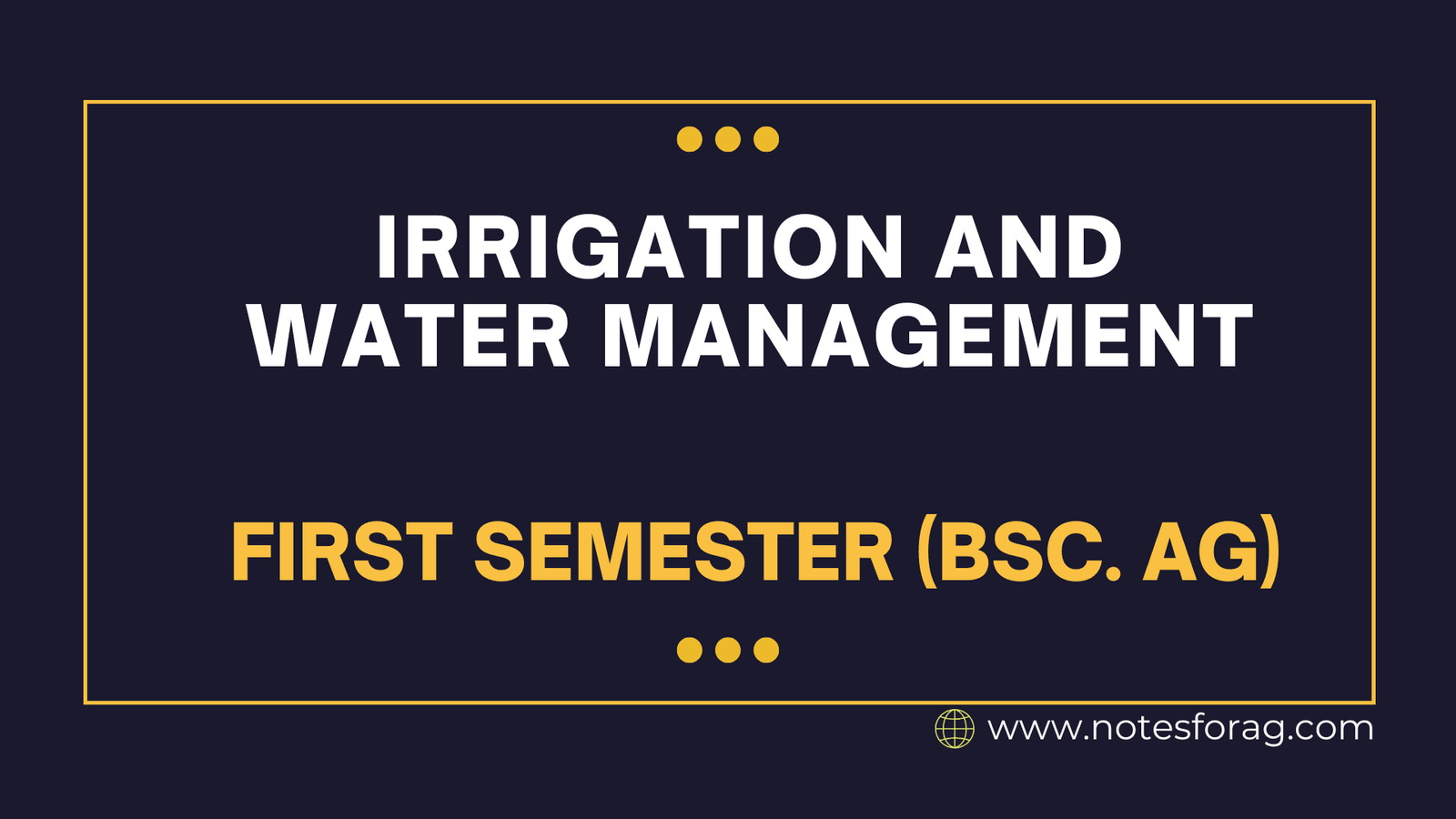Irrigation and water management involve the controlled application and efficient use of water to support plant growth and optimize agricultural productivity while conserving water resources. Irrigation refers to the process of supplying water to plants or crops through various methods, typically to supplement natural rainfall. It is an essential agricultural practice, especially in regions where water resources are limited or rainfall is insufficient to meet crop needs. Irrigation helps to ensure that plants receive consistent moisture, which is vital for their growth and development.

There are several types of irrigation methods, including surface irrigation, drip irrigation, sprinkler irrigation, and subsurface irrigation, each having its own advantages depending on the crop, soil, and available water resources. Proper irrigation improves crop yield, conserves water, and supports sustainable agriculture.
Table of Contents
Water is a critical resource for agricultural productivity, and efficient irrigation management is essential for ensuring sustainable crop production. Water management refers to the efficient and sustainable use, distribution, and conservation of water resources to meet agricultural, industrial, and domestic needs. Proper irrigation techniques not only maximize water efficiency but also enhance soil health, increase crop yields, and mitigate the effects of drought and water scarcity. This document explores various irrigation methods and strategies to improve water use efficiency in agriculture.
1. Importance of Irrigation and Water Management
Efficient irrigation and water management contribute significantly to sustainable agriculture by:
1. Irrigation and Water management ensure a reliable water supply for crops.
2. Irrigation and water management improve soil moisture retention and preventing soil degradation.
3. Irrigation and Water management reduce water wastage and lowering production costs.
4. Mitigating the effects of climate change and water scarcity.
5. irrigation and water management enhance food security by stabilizing crop yields.
2. Types of Irrigation Techniques
Different irrigation methods are used based on soil type, crop requirements, and available water resources. The major irrigation techniques include:
2.1. Surface Irrigation
Surface irrigation is one of the oldest and most commonly used methods, where water is applied directly to the soil surface and allowed to infiltrate. Types of surface irrigation include:
Flood Irrigation: Water is released onto the field and spreads across the soil. It is simple but can lead to excessive water loss.
Furrow Irrigation: Water is channeled through small trenches between crop rows, reducing evaporation and runoff.
Basin Irrigation: Used for crops like rice, where fields are divided into basins filled with water.
2.2. Drip Irrigation

Drip irrigation delivers water directly to plant roots through a network of pipes and emitters, ensuring precise application.
- Advantages: Reduces water wastage, prevents soil erosion, and minimizes weed growth.
- Disadvantages: Initial setup costs are high, and regular maintenance is required.
2.3. Sprinkler Irrigation
Sprinkler systems distribute water through high-pressure sprinklers, simulating natural rainfall.
- Advantages: Suitable for a variety of crops and soil types, effective for large fields.
- Disadvantages: High energy costs and water loss due to evaporation and wind drift.
2.4. Subsurface Irrigation
This technique delivers water below the soil surface through underground pipes or drip lines, minimizing evaporation.
- Advantages: Improves water efficiency, reduces weed growth, and prevents surface runoff.
- Disadvantages: Expensive installation and potential clogging of underground pipes.
2.5. Center Pivot Irrigation
A mechanized system where sprinklers rotate around a central pivot, providing uniform water distribution.
- Advantages: Reduces labor requirements and covers large areas efficiently.
- Disadvantages: Requires significant investment and high operational costs.
3. Enhancing Water Use Efficiency
Water use efficiency is crucial for sustainable irrigation. The following strategies help in optimizing water usage:
3.1. Scheduling Irrigation Efficiently
- Use weather data and soil moisture sensors to determine the right time for irrigation.
- Avoid over-irrigation, which leads to waterlogging and nutrient leaching.
- Implement deficit irrigation, supplying just enough water to meet crop needs.
3.2. Soil and Crop Management Practices
- Mulching: Applying organic or plastic mulch reduces evaporation and improves soil moisture retention.
- Cover Crops: Growing cover crops prevents soil erosion and enhances moisture conservation.
- Crop Rotation: Alternating crops improves soil structure and water absorption capacity.
3.3. Adopting Water-Saving Technologies
- Soil Moisture Sensors: Monitor soil moisture levels to irrigate efficiently.
- Smart Irrigation Systems: Use automated systems with real-time data to adjust irrigation schedules.
- Laser Land Leveling: Ensures uniform water distribution by creating even fields.
3.4. Reducing Water Losses
- Prevent Runoff: Construct contour bunds or terraces to slow down water flow and enhance absorption.
- Reduce Evaporation: Apply irrigation during cooler hours (morning or evening) to minimize water loss.
- Minimize Wind Drift: Use low-pressure sprinklers or windbreaks to reduce water loss due to wind.
4. Challenges in Irrigation and Water Management
Despite advancements, irrigation faces several challenges, including:
- Water Scarcity: Limited freshwater availability due to overuse and climate change.
- Salinity and Waterlogging: Poor drainage can lead to soil salinity and reduced crop productivity.
- High Costs: Installation and maintenance of advanced irrigation systems require significant investment.
- Infrastructure Limitations: Poorly maintained canals and outdated irrigation networks reduce efficiency.
5. Sustainable Irrigation Practices

Sustainability in irrigation ensures long-term agricultural productivity while conserving water resources. Sustainable practices include:
- Rainwater Harvesting: Collecting and storing rainwater for irrigation during dry periods.
- Recycled Water Use: Treating and reusing wastewater for irrigation reduces dependency on freshwater sources.
- Agroforestry: Integrating trees with crops enhances water retention and reduces soil erosion.
- Community-Based Water Management: Encouraging collective irrigation planning and resource-sharing among farmers.
6. Case Studies of Efficient Irrigation
6.1. Israel’s Drip Irrigation Success
Israel, a water-scarce country, revolutionized agriculture through drip irrigation, increasing crop yields while reducing water use.
6.2. India’s Micro-Irrigation Projects
India has promoted micro-irrigation (drip and sprinkler) to conserve water, improve productivity, and enhance farmer incomes.
6.3. Australia’s Precision Irrigation Techniques
Australia uses soil moisture monitoring and automated irrigation to optimize water application and prevent wastage.
7. Future of Irrigation and Water Management
The future of irrigation lies in technological advancements and sustainable practices. Emerging trends include:
- Artificial Intelligence and Machine Learning: AI-driven irrigation systems optimize water distribution based on real-time data.
- Drought-Resistant Crops: Genetic engineering and breeding programs develop crops requiring less water.
- Solar-Powered Irrigation: Solar pumps provide sustainable energy for irrigation in remote areas.
Conclusion
Effective irrigation and water management are critical for sustainable agriculture and food security. By adopting advanced irrigation techniques, improving water use efficiency, and implementing sustainable practices, farmers can optimize crop production while conserving water resources. As climate change and population growth increase pressure on water availability, innovations in irrigation technology and efficient management will play a key role in ensuring agricultural sustainability.
Frequently Asked Questions (FAQ)
What is the most efficient irrigation method?
Drip irrigation is considered the most efficient method as it delivers water directly to plant roots, reducing evaporation and runoff.
How can farmers improve water use efficiency?
Farmers can enhance efficiency by using soil moisture sensors, scheduling irrigation effectively, applying mulching, and adopting smart irrigation systems.
What role does technology play in modern irrigation?
Technology such as AI, IoT-based sensors, automated irrigation systems, and precision farming techniques optimize water use and improve crop productivity.
Related Articles

